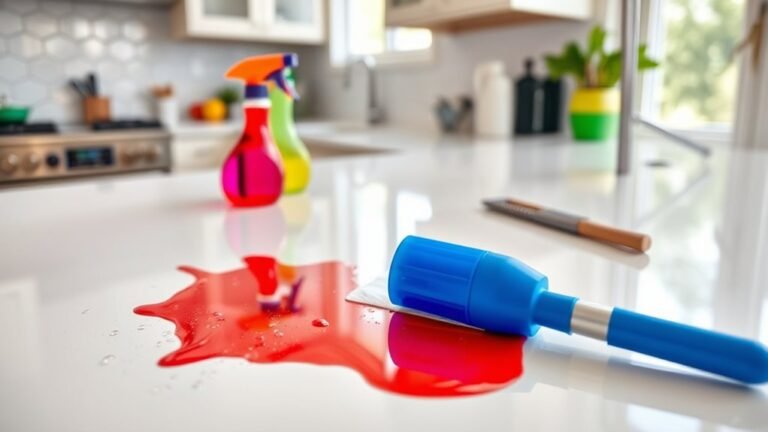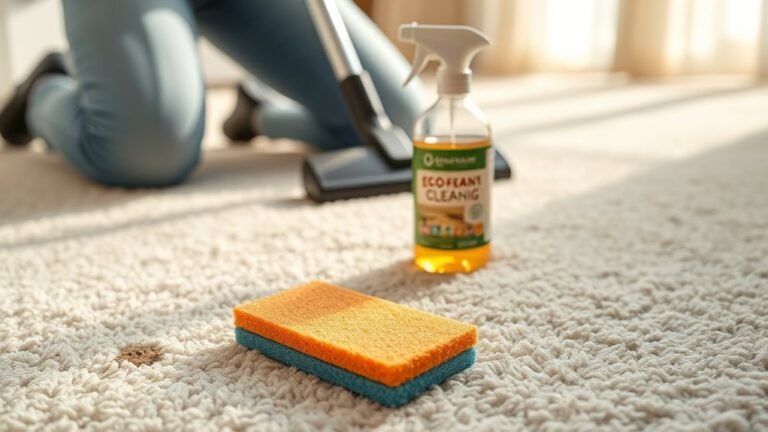Removing Mold Stains From Coffee Machine
To remove mold stains from your coffee machine, start by unplugging it and emptying the water reservoir. Use vinegar to run a cleaning cycle, breaking down mold inside. Scrub removable parts with warm, soapy water and a soft brush, rinsing well and letting them dry fully. Baking soda paste works great for stubborn spots. Prevent mold by drying parts after use and flushing with clean water weekly. Following safe cleaning steps keeps your machine fresh—there’s more to know about maintaining mold-free coffee gear.
Understanding Mold Growth in Coffee Machines

Although you might not see it right away, mold can quickly develop inside your coffee machine, especially in damp, warm areas. Understanding the mold life cycle helps you take control—it starts with spores landing on moist surfaces, then growing into colonies when conditions are right. Your coffee machine creates a perfect environment for this if moisture control isn’t prioritized. Every time you brew, water lingers in hidden corners, feeding mold growth. To keep your freedom from mold’s grip, you need to disrupt this cycle by drying out your machine thoroughly after each use and regularly cleaning it. Taking these simple steps means you won’t be trapped by mold’s persistence, keeping your coffee fresh and your machine safe without hassle.
Identifying Common Mold Stains and Odors
When you start noticing a musty smell or dark spots inside your coffee machine, it’s a strong sign that mold has taken hold. Using mold identification techniques and odor detection methods will help you pinpoint the problem quickly, ensuring your freedom from unwanted contamination.
| Mold Stain Appearance | Odor Characteristics |
|---|---|
| Black or dark green | Musty, damp |
| White fuzzy patches | Earthy, stale |
| Slimy green film | Sour, unpleasant |
| Brown spots | Moldy, damp wood-like |
| Powdery white patches | Funky, ammonia-like smell |
Recognizing these signs lets you act swiftly to keep your coffee machine clean and your daily brew fresh and safe.
Essential Tools and Cleaning Supplies Needed

To tackle mold stains effectively, you’ll need the right cleaning agents like vinegar or specialized mold removers. Don’t forget to protect yourself with gloves and a mask to avoid irritation. Having brushes and cloths handy will make it easier to scrub away the mold from your coffee machine.
Cleaning Agents Overview
Since mold stains can be stubborn, you’ll need the right cleaning agents to tackle them effectively. You have two main options: natural cleaners and chemical agents. Natural cleaners like vinegar, baking soda, and lemon juice offer a safer, eco-friendly approach that’s gentle on your coffee machine and your health. If you prefer something stronger, chemical agents such as bleach or commercial mold removers can quickly break down tough mold stains. However, they require careful handling and proper rinsing to protect your machine and yourself. Choosing the right cleaning agent depends on your comfort level and how deep the mold has penetrated. Either way, having these agents ready gives you the freedom to restore your coffee maker to its mold-free, fresh state without hassle.
Protective Gear Essentials
Although removing mold stains might seem straightforward, you’ll want the right protective gear to keep yourself safe throughout the process. First, always wear protective gloves to shield your hands from harsh cleaning agents and mold spores. These gloves prevent skin irritation and reduce the risk of contamination. Safety goggles are equally important; they protect your eyes from splashes and airborne particles, keeping your vision clear and safe. Don’t skip these essentials, especially when working in tight spaces like a coffee machine’s interior. Wearing the proper gear gives you the freedom to clean confidently without worrying about exposure. Investing in quality protective gloves and safety goggles guarantees you can tackle mold stains effectively while prioritizing your health and safety every step of the way.
Tools for Mold Removal
Before you plunge into cleaning your coffee machine, you’ll need the right tools and supplies to tackle mold effectively. Mold growth can hide in tiny crevices, so gather essentials like a soft-bristle brush, microfiber cloths, and a small toothbrush for detailed scrubbing. You’ll also want a spray bottle filled with a mold-fighting solution—white vinegar or a mild bleach mix works well. Don’t forget gloves and a mask to protect yourself from spores during the process. Having these cleaning supplies ready means you’re in control, ready to erase mold without hassle. With the right gear, you can keep your coffee machine fresh and safe, ensuring every cup tastes just right, free from unwanted mold contamination.
Preparing Your Coffee Machine for Cleaning

Once you decide to tackle the mold stains, the first step is to unplug your coffee machine and let it cool completely. This guarantees your safety and prevents any damage during cleaning. Regular coffee machine maintenance is key to avoiding stubborn mold buildup, so keeping a consistent cleaning frequency helps you enjoy fresher brews and more freedom from worries.
Here’s a quick prep checklist:
| Step | Purpose |
|---|---|
| Unplug machine | Safety first |
| Cool down | Prevent burns |
| Empty water reservoir | Remove old water and residue |
| Detach removable parts | Easier, thorough cleaning |
Following these steps sets you up for a smooth cleaning process and keeps your coffee machine running freely without mold interference.
Using Vinegar to Remove Mold Stains
After you’ve prepped your coffee machine, vinegar is one of the most effective and natural solutions to tackle mold stains. Its acidic properties break down mold quickly, making cleaning straightforward and safe without harsh chemicals. Pour white vinegar into the water reservoir and run a brew cycle to let it work through the internal parts. This not only removes mold but also helps with mold prevention by eliminating lingering spores. Afterward, run a couple of cycles with clean water to flush out any vinegar residue. The vinegar benefits extend beyond cleaning—it’s affordable, eco-friendly, and easy to find. Using vinegar lets you reclaim control over your coffee machine’s cleanliness, freeing you from mold worries and ensuring every cup tastes fresh and pure.
Applying Baking Soda for Deep Cleaning
You can make a simple baking soda paste by mixing it with a little water to tackle stubborn mold stains. Apply the paste to affected areas, let it sit for about 15 minutes, then scrub gently to lift the grime. This method helps get deep into crevices where mold often hides in your coffee machine.
Baking Soda Paste
Although mold stains can be stubborn, applying a baking soda paste offers a simple yet effective way to tackle deep cleaning in your coffee machine. Baking soda benefits include its natural ability to break down grime and neutralize odors without harsh chemicals. To make the paste, mix baking soda with a little water until it forms a spreadable consistency. This baking soda application allows you to target moldy spots directly, loosening buildup and making stains easier to remove. Plus, it’s safe for most coffee machine surfaces, helping you maintain freedom from toxic cleaners. Using this paste, you’ll restore your machine’s cleanliness, ensuring every cup tastes fresh. Embrace this straightforward method—it’s a powerful step toward a mold-free coffee experience.
Cleaning Process Steps
Start by unplugging your coffee machine and letting it cool completely to guarantee safe handling. Next, mix baking soda with a little water to create a thick paste. Apply this paste directly to moldy or stained areas inside the machine, focusing on spots where mold tends to linger. Let it sit for about 15 minutes to break down stubborn residue. Then, use a soft brush or cloth to scrub gently, avoiding damage to delicate parts. Rinse thoroughly with clean water to remove all baking soda traces. For effective mold prevention, repeat this deep cleaning every few weeks, depending on your cleaning frequency and usage. Staying consistent with this routine not only keeps your coffee tasting fresh but also gives you the freedom to enjoy your brew without worrying about mold buildup.
Cleaning Removable Parts Thoroughly
Since removable parts often trap moisture and residue, cleaning them thoroughly is vital to prevent mold buildup in your coffee machine. Start by detaching all removable components—like the water reservoir, drip tray, and filter basket. Give each piece a thorough inspection to spot any hidden mold or stubborn stains. Use warm, soapy water and a soft brush or cloth to scrub every surface, paying close attention to crevices where mold can hide. Rinse them well to remove soap residue, then let them air dry completely before reassembling. Taking these steps guarantees your machine stays mold-free and safe to use, giving you the freedom to enjoy fresh coffee without worry. Don’t skip this vital step if you want your coffee machine running smoothly and hygienically.
Preventing Mold Buildup With Regular Maintenance
To keep mold from returning, you’ll need to stick to a regular maintenance routine for your coffee machine. Mold prevention starts with consistent cleaning—rinse and dry removable parts after every use to avoid moisture buildup. Make it a habit to flush the machine with clean water weekly, preventing residue that invites mold growth. Don’t forget to check and clean the water reservoir regularly, as stagnant water is a prime spot for mold. Scheduling routine maintenance not only keeps your machine fresh but also guarantees your freedom to enjoy great coffee without worry. By committing to these simple steps, you’ll keep mold at bay and extend your machine’s life effortlessly. Staying proactive with mold prevention is your best defense.
Safe Practices for Handling Mold in Appliances
Although mold might seem harmless, handling it improperly in your coffee machine can pose health risks and damage your appliance. To enjoy mold-free coffee, you need to prioritize mold prevention by maintaining the right cleaning frequency. Here’s a quick guide to keep you safe and your machine fresh:
| Practice | Tip |
|---|---|
| Wear Gloves | Protect your skin from mold spores |
| Use Vinegar Solution | Natural, effective mold remover |
| Ventilate Area | Reduce moisture, inhibit mold growth |
| Clean Weekly | Maintain ideal cleaning frequency |
When to Replace Your Coffee Machine Due to Mold Damage
If you notice stubborn mold patches that won’t come off or a persistent musty smell, it might be time to contemplate replacing your coffee machine. Mold can pose serious health risks, especially if you have allergies or respiratory issues. Evaluating these signs early helps protect your health and guarantees your coffee stays safe to drink.
Signs of Severe Mold
Persistent black or green patches inside your coffee machine often signal severe mold growth that regular cleaning can’t fix. If you notice these signs, it’s time to contemplate replacing your machine rather than relying solely on mold detection methods or mold prevention tips.
Watch out for:
- A musty or sour smell that lingers despite cleaning.
- Mold spreading to hard-to-reach areas like internal tubing.
- Discolored water or slime buildup inside the reservoir.
- Frequent mold reappearance even after thorough cleaning.
When you see these signs, your coffee maker’s freedom from mold is compromised. Don’t hold back—prioritize your health and convenience by replacing the machine to enjoy mold-free coffee without constant worry.
Health Risks Evaluation
When mold has deeply penetrated your coffee machine, the health risks can quickly outweigh the benefits of continued use. If you notice persistent mold stains despite cleaning, or if mold has spread into hard-to-reach internal parts, it’s time to contemplate replacing the machine. Mold allergies can trigger sneezing, coughing, or even more serious health symptoms like headaches and respiratory issues, which you don’t want lurking in your daily brew. Continuing to use a compromised machine risks exposing you to these hazards every morning. You deserve freedom from worry and illness, so if your coffee maker shows signs of severe mold damage or if health symptoms arise after use, don’t hesitate to invest in a new one. Your well-being comes first—choose safety over stubbornness.
Frequently Asked Questions
Can Mold in Coffee Machines Cause Allergic Reactions?
Yes, mold can cause allergic reactions, and if you’re sensitive, you might notice mold symptoms like sneezing, coughing, or itchy eyes. You don’t want to feel trapped by these issues, especially from something as simple as your coffee machine. Mold spores can easily trigger these reactions, so it’s smart to keep your machine clean to enjoy your freedom from discomfort and breathe easy while sipping your coffee.
Is It Safe to Drink Coffee Immediately After Cleaning Mold?
You might wonder if it’s safe to drink coffee right after cleaning. With proper cleaning methods, your coffee safety is usually secure. Just make sure you thoroughly rinse and run a few water-only cycles to flush out any cleaning residues. Don’t rush it—letting your machine dry fully also helps. That way, you’re free to enjoy your brew without worries, knowing your coffee tastes great and is safe to sip.
Does Hard Water Contribute to Mold Growth in Coffee Machines?
Imagine your coffee machine as a fortress protecting your daily freedom. Hard water is like an uninvited miner, leaving behind mineral buildup that weakens your fortress walls. This buildup creates tiny hiding spots where mold can easily grow, threatening the purity of your brew. To keep your fortress strong and your coffee free, you’ve got to regularly clean and use filtered water — that way, you’re in control, not the stubborn minerals or mold.
Can Commercial Coffee Pods Harbor Mold Inside the Machine?
You might wonder if commercial coffee pods can harbor mold inside your machine. While the pods themselves are sealed, poor coffee pod hygiene—like leaving used pods inside or not cleaning the machine regularly—can create a mold-friendly environment. To keep your freedom from mold worries, focus on mold prevention by promptly removing used pods and routinely cleaning your machine. This way, you enjoy fresh coffee without any unwanted surprises.
Are There Mold-Resistant Coffee Machine Models Available?
You’ll be glad to know some coffee machine models use mold resistant materials that help keep your brew area cleaner and healthier. Look for features like self-cleaning cycles, antimicrobial coatings, and easy-to-disassemble parts, which make maintenance simpler and prevent mold buildup. Choosing a machine with these coffee machine features means you can enjoy your coffee without worrying about hidden mold, giving you the freedom to savor every cup worry-free.






